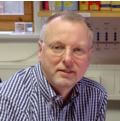 Mendelspod host Theral Timpson recently interviewed Professor Steven Marsh, Director of Bioinformatics at the Anthony Nolan Research Institute, a UK-based organization dedicated to improving the outcomes of bone marrow transplantation and host to the world’s first bone marrow registry. Prof. Marsh and his team have dramatically improved the resolution of HLA typing — one of the methods used for matching compatible donors with transplant recipients — using long, accurate reads from PacBio sequencing. Their fascinating conversation covers the past, present, and future of HLA typing — highlights are below.
Mendelspod host Theral Timpson recently interviewed Professor Steven Marsh, Director of Bioinformatics at the Anthony Nolan Research Institute, a UK-based organization dedicated to improving the outcomes of bone marrow transplantation and host to the world’s first bone marrow registry. Prof. Marsh and his team have dramatically improved the resolution of HLA typing — one of the methods used for matching compatible donors with transplant recipients — using long, accurate reads from PacBio sequencing. Their fascinating conversation covers the past, present, and future of HLA typing — highlights are below.
Short History of HLA Typing — There’s a Lot More Diversity than We Thought
When Marsh entered the field 30 years ago, HLA typing was performed with serology, and there were just 119 known HLA antigens. “We thought 119 was a lot of diversity,” he says. With the advent of genomic tools in the 1990s, researchers have had to evolve their practices for typing as more and more became known about the nature of HLA genes. “We’ve really realized that these genes are not just polymorphic, they are really hyper-polymorphic,” he says. The HLA B gene alone has 4,000 variants, Marsh notes. “The only way to do proper HLA typing in this day and age is to do sequencing,” he says.
Enter Long Reads and Exquisite Haplotypes
Using PacBio sequencing technology, Anthony Nolan aimed to extend its sequencing from a couple of gene exons to cover the full HLA genes and capture phasing information. “We’re seeing exquisite haplotypes … all the way through the HLA region,” Marsh says, noting that this gives them “very high resolution typing and very high allelic specificity.”
Marsh says he has been offered free NGS machines from other vendors, but for him, “those technologies would be a distraction.” The MHC/HLA genes are very GC-rich, he explains, making it difficult to use short-read sequencing technologies because of their high systematic error rates. “You cannot assign phase across the whole gene sequence for some allele combinations,” he says.
For Marsh, the future lies with the long-read sequencing capabilities of PacBio. “For me, it’s groundbreaking technology,” he says. One example of the unique capabilities provided to the Anthony Nolan team by PacBio sequencing is 3.5 kb contiguous sequences for HLA Class I genes, including all of the exons and introns, as demonstrated in a recent publication.
Complete, High-Resolution Typing — The Way Forward
Marsh is using the PacBio platform exclusively for his sequencing program and is already seeing the benefits of high-resolution typing. His goal: to speed up the process and improve matching preciseness to save lives. Anthony Nolan is the first group in the world to take this strategy to the clinic, and is using multiplexing to make the process more cost effective. “We really believe in [the PacBio technology], and we believe it will make an impact for patients,” he says.
The scientists at Anthony Nolan continue to gain deeper knowledge about HLA genes and have future plans to expand their focus to other relevant immune related regions, such as the KIR. They will also continue to explore other important genes comprised within the MHC locus such as MIC-A etc.
Click here to listen to the full podcast.
November 9, 2015 | General